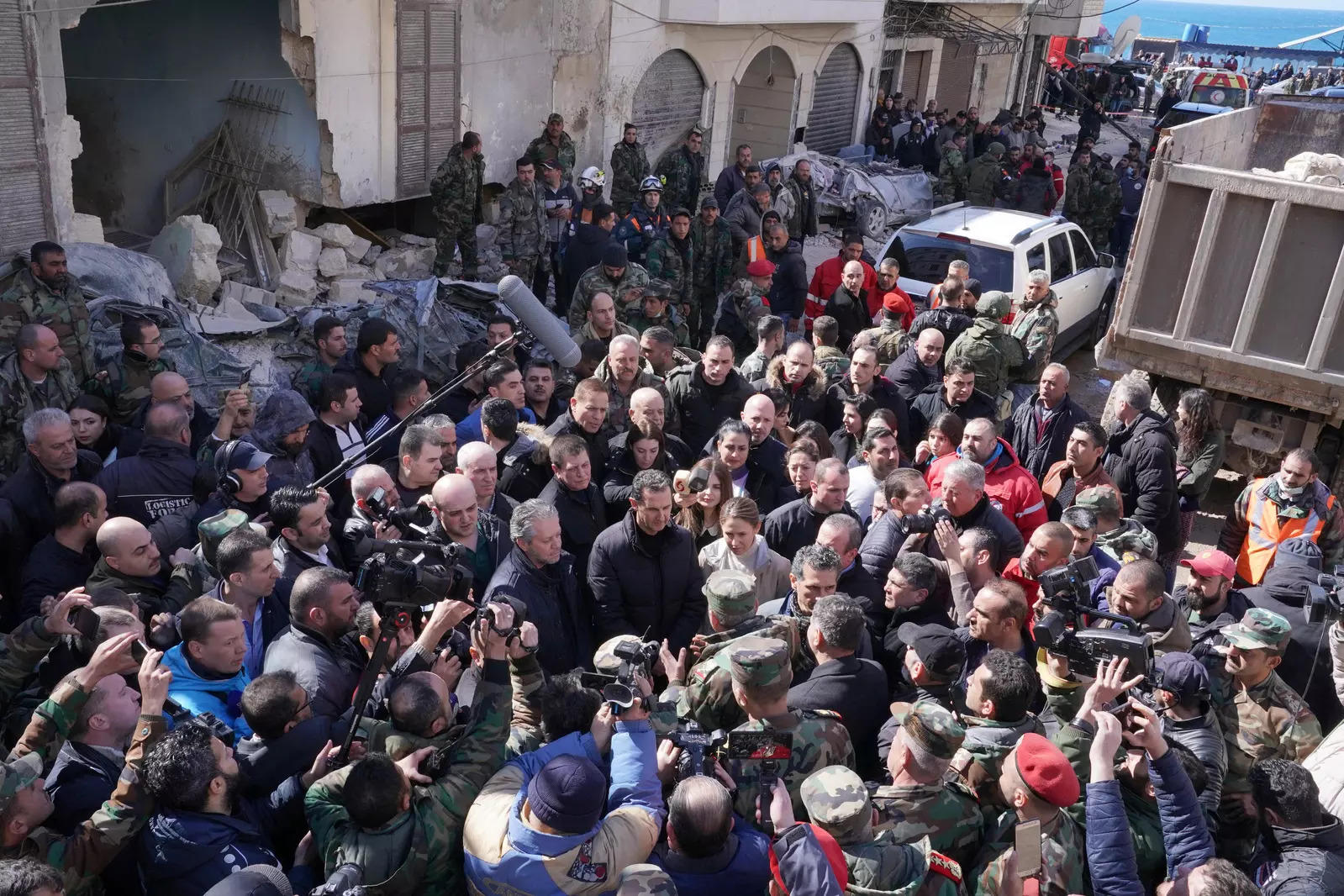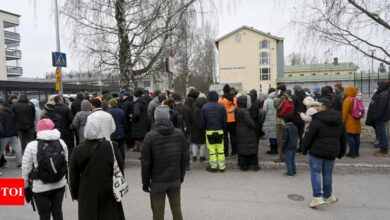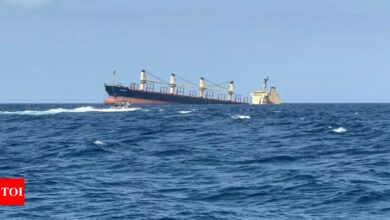World
Syria: How Syria’s war has hindered earthquake relief

[ad_1]
Thousands of people have been killed in Syria by the earthquake that struck its border region with Turkey on Feb. 6 but aid has been slow to reach the most affected areas.
Relief efforts have been hampered by a civil war that has splintered the country and divided regional and global powers.
Here is a summary of challenges facing aid delivery in Syria.
Civil war
After nearly 12 years of conflict, Syria is fractured.
President Bashar al-Assad, backed by Russia and Iran, has regained control of much of the country but hardline opposition groups and Turkey-backed fighters control the northwest, where the United Nations says 4 million people needed assistance even before the earthquake.
The rebel-held northwest is the area in Syria hardest hit by the 7.8 magnitude earthquake, although nearby government-controlled regions have also suffered widespread casualties and destruction.
A larger area in the northeast is controlled by a U.S.-backed, Kurdish-led force. That area has been less affected by the earthquake.
How can aid enter?
Assad‘s government says foreign countries should respect Syria’s sovereignty and that aid for any part of the country should enter via territory under government control.
In practice, aid for the rebel-held northwest has for years been delivered across the border from neighbouring Turkey, but the process requires U.N. Security Council approval every six months.
Russia, a veto-wielding council member which supports the Damascus government, has only approved opening a single crossing from Turkey into the northwest, saying U.N. aid should instead be channelled through Damascus and then across the front lines.
U.N. aid chief Martin Griffiths, who was visiting Syria on Monday, is lobbying at the United Nations to open additional crossings from Turkey to bring earthquake relief.
Can aid cross the front line?
A few efforts to deliver humanitarian aid across Syria’s internal front lines since the earthquake struck have shown how fraught and difficult the process is.
A convoy from the Kurdish-led northeast destined for an area in the northwest held by Turkey-backed rebel factions – enemies that have fought numerous bouts of conflict during the civil war – was turned back on Thursday.
Sources on both sides traded blame for why the convoy didn’t cross, accusing each other of trying to politicise aid.
On Sunday a U.N. spokesperson said aid from government-held Syria into an area controlled mostly by a hardline Islamist group was held up by “approval issues”.
A source from the group, Hayat Tahrir al-Sham, said it would not allow shipments from government-held areas.
Who is sending aid?
Western countries have sought to isolate Assad since the outbreak of the conflict, which they blame on his forceful crackdown against widespread protests in 2011.
They have imposed economic sanctions on Damascus and provided little direct aid, although they say sanctions do not target relief work and are still major donors to United Nations and other aid operations that do work out of Damascus.
Since the earthquake, Syrian state media say more than 50 planes have delivered aid from Arab and Asian countries to airports in government-controlled areas.
Italian medical aid arrived in Damascus on Sunday, the first European earthquake help to arrive to government zones.
Direct Western support for the northwest has also been affected by the rise to power there of hardline groups and the earthquake disrupted cross-border deliveries for three days.
Deliveries resumed on Thursday and have been ramping up since but only included food, medical equipment and shelter – not the excavators and other equipment that rescuers in the northwest say they desperately need.
Relief efforts have been hampered by a civil war that has splintered the country and divided regional and global powers.
Here is a summary of challenges facing aid delivery in Syria.
Civil war
After nearly 12 years of conflict, Syria is fractured.
President Bashar al-Assad, backed by Russia and Iran, has regained control of much of the country but hardline opposition groups and Turkey-backed fighters control the northwest, where the United Nations says 4 million people needed assistance even before the earthquake.
The rebel-held northwest is the area in Syria hardest hit by the 7.8 magnitude earthquake, although nearby government-controlled regions have also suffered widespread casualties and destruction.
A larger area in the northeast is controlled by a U.S.-backed, Kurdish-led force. That area has been less affected by the earthquake.
How can aid enter?
Assad‘s government says foreign countries should respect Syria’s sovereignty and that aid for any part of the country should enter via territory under government control.
In practice, aid for the rebel-held northwest has for years been delivered across the border from neighbouring Turkey, but the process requires U.N. Security Council approval every six months.
Russia, a veto-wielding council member which supports the Damascus government, has only approved opening a single crossing from Turkey into the northwest, saying U.N. aid should instead be channelled through Damascus and then across the front lines.
U.N. aid chief Martin Griffiths, who was visiting Syria on Monday, is lobbying at the United Nations to open additional crossings from Turkey to bring earthquake relief.
Can aid cross the front line?
A few efforts to deliver humanitarian aid across Syria’s internal front lines since the earthquake struck have shown how fraught and difficult the process is.
A convoy from the Kurdish-led northeast destined for an area in the northwest held by Turkey-backed rebel factions – enemies that have fought numerous bouts of conflict during the civil war – was turned back on Thursday.
Sources on both sides traded blame for why the convoy didn’t cross, accusing each other of trying to politicise aid.
On Sunday a U.N. spokesperson said aid from government-held Syria into an area controlled mostly by a hardline Islamist group was held up by “approval issues”.
A source from the group, Hayat Tahrir al-Sham, said it would not allow shipments from government-held areas.
Who is sending aid?
Western countries have sought to isolate Assad since the outbreak of the conflict, which they blame on his forceful crackdown against widespread protests in 2011.
They have imposed economic sanctions on Damascus and provided little direct aid, although they say sanctions do not target relief work and are still major donors to United Nations and other aid operations that do work out of Damascus.
Since the earthquake, Syrian state media say more than 50 planes have delivered aid from Arab and Asian countries to airports in government-controlled areas.
Italian medical aid arrived in Damascus on Sunday, the first European earthquake help to arrive to government zones.
Direct Western support for the northwest has also been affected by the rise to power there of hardline groups and the earthquake disrupted cross-border deliveries for three days.
Deliveries resumed on Thursday and have been ramping up since but only included food, medical equipment and shelter – not the excavators and other equipment that rescuers in the northwest say they desperately need.
#Syria #Syrias #war #hindered #earthquake #relief





